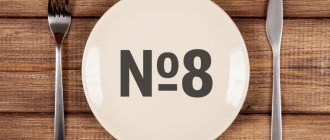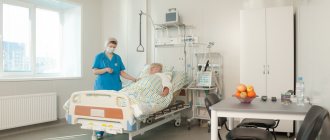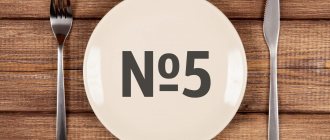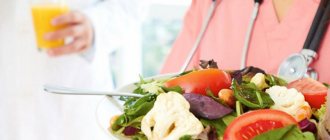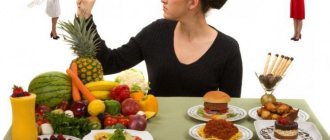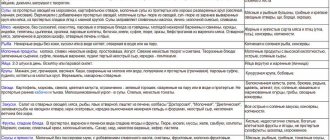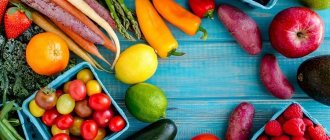Constant stress, anxiety, increased excitability - these are the problems that modern people often face. Along with drug treatment and the participation of a psychologist in therapy, it is recommended to introduce diet table No. 12. It was this diet that was developed at the beginning of the last century to calm the nervous system and reduce the level of excitability. Its effectiveness has been confirmed by scientific research more than once.
Indications for switching to a diet
Medical nutrition Table 12
Table No. 12 is indicated for nervous disorders accompanied by increased excitability:
- neuroses and similar conditions - neurasthenia, psychasthenia, hysteria;
- VSD;
- syndromes caused by stressful situations.
It is not possible to cope with neurological pathologies with diet alone. Food helps alleviate the patient’s condition, and treatment requires medications prescribed by a doctor.
Advantages and disadvantages
It takes time to get the desired result, but in the meantime it is necessary to find out what advantages and disadvantages the proposed power system has. There are more advantages, which is why dietary table 12 is very popular among the masses and collects positive reviews from doctors and patients. So:
- Nutrition for neuroses is balanced and fortified, and can be recommended for a very long period.
- A diet for neuroses does not require special culinary talents; even a beginner in the culinary arts can prepare healthy dishes.
- The therapeutic diet provides a moderate sedative effect without harm to the patient’s health; the psyche and gastrointestinal tract are not affected.
There are almost no downsides to this treatment, however, reviews from doctors report that it takes time to ensure positive dynamics of the underlying disease. Simply put, emotional balance does not occur immediately. In addition, a specific diet for depression can make you sad and provoke extremely unwanted blues and apathy.
Article on the topic: Cryodestruction of papillomas
Diet principles
Diet No. 12 is based on limiting the diet of foods that have a stimulating effect on nerve cells.
Nutritionists recommend reducing the amount of carbohydrates, adding less salt to dishes (6 g is the maximum that a patient can afford), avoiding spices, and minimizing the consumption of fatty foods. The list of products not recommended for nervous diseases is small. It’s easy to find a replacement for them, so you can cook delicious and healthy dishes. Daily calorie content is 2300-2500 kcal, which allows you not to feel hungry. Diet No. 12 is not limited in time or age. You can stay on it for quite a long time - until the nervous system is completely restored.
Any cooking is allowed, but doctors advise avoiding frying. The recommended eating regimen is at least 5 times a day in small portions. It is advisable to eat at the same time in a familiar home environment.
Along with the diet, walks in the fresh air and daytime rest are necessary. And you will have to give up active physical education and sports.
General recommendations
The goal of diet number 12 is to reduce the load on the nervous system, so all foods that can affect it are excluded - coffee, alcohol, fried and spicy foods. Preference is given to foods saturated with phosphorus salts, and therefore having a positive effect on the nervous system - milk and dairy products, legumes, liver.
In general, the “Table 12” diet is a fairly high-calorie diet - 2300-2400 Kcal, but the amount of salt is reduced to 6 grams per day.
Diet 12 involves five meals per day.
The next article contains all the dietary tables according to Pevzner, download the file with the menu and see the recipes.
Table of permitted and prohibited products
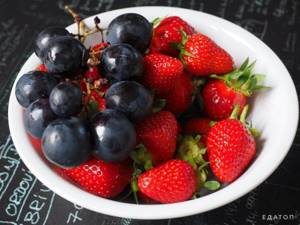
Before preparing meals that comply with Diet No. 12, it is recommended that you familiarize yourself with which foods are allowed and which are prohibited. The following table reflects this information:
| Products or dishes | Allowed | Forbidden |
| Soups. | Any, cooked in low-fat broth, dairy. | Anything cooked in broths made from fatty meats. |
| Meat fish. | Low-fat dietary. | Lard, meat and fatty fish, processed products. |
| Side dishes. | Any cereals, durum pasta. | Pasta made from soft wheat varieties. |
| Dairy products. | Any low fat. | Cheese of fatty and salty varieties. |
| Vegetables. | Any food that does not cause excitement, fresh or cooked (not fried). | Radish, sorrel, onions, cucumbers, garlic. |
| Fruits. | Anything that contains little fiber. | High in fiber. |
| Sweets. | Honey and jam, pastille, marmalade. | Chocolate, cakes and pastries with rich cream. |
| Bread. | Slightly dried, yesterday's. | Rich, freshly baked. |
| Beverages. | Green tea, fruit juices, jelly, compotes, fruit drinks. | Coffee, black tea, alcoholic drinks, carbonated sweet drinks. |
| Other. | Eggs. | Canned food, marinades, hot sauces. |
Menu for the week
Here is a menu you can create for a week, following the recommendations of diet 12:
Print menu “Table No. 12”
| Monday: | |
| Breakfast |
|
| Lunch |
|
| Dinner |
|
| Afternoon snack |
|
| Dinner |
|
| Tuesday: | |
| Breakfast |
|
| Lunch |
|
| Dinner |
|
| Afternoon snack |
|
| Dinner |
|
| Wednesday: | |
| Breakfast |
|
| Lunch |
|
| Dinner |
|
| Afternoon snack |
|
| Dinner |
|
| Thursday: | |
| Breakfast |
|
| Lunch |
|
| Dinner |
|
| Afternoon snack |
|
| Dinner |
|
| Friday: | |
| Breakfast |
|
| Lunch |
|
| Dinner |
|
| Afternoon snack |
|
| Dinner |
|
| Saturday: | |
| Breakfast |
|
| Lunch |
|
| Dinner |
|
| Afternoon snack |
|
| Dinner |
|
| Sunday: | |
| Breakfast |
|
| Lunch |
|
| Dinner |
|
| Afternoon snack |
|
| Dinner |
|
Diet recipes
Eating according to diet number 12 is not difficult, because...
There are many recipes available. It's easy to make meatball soup, which requires the following ingredients:
- lean minced meat - 200 g;
- potatoes - 2 pcs. small or 1 pc. big;
- durum vermicelli - 100 g;
- chicken egg - 1 pc.;
- onions - 1 pc.;
- carrots - 1 pc.;
- vegetable oil (preferably olive) - 1 tbsp. l.;
- parsley and dill - a sprig.
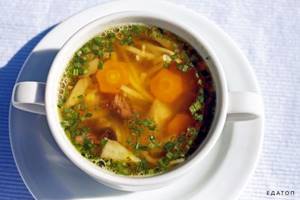
All vegetables are peeled and cut - potatoes into cubes, onions are chopped, and carrots can be grated. The egg is added to the minced meat, chopped greens go there too, everything is mixed well. Small meatballs are formed from the mass. Potatoes are added to the water and the container is placed on the stove. Onions and carrots are lightly fried. As soon as the potatoes are cooked until half cooked, you should add meatballs, vermicelli, and frying to the soup. Cook for 5-10 minutes, leave for 30 minutes. A healthy and tasty dish is lentil and pea puree. It will require:
- lentils and peas - 0.5 cups each;
- carrots and onions - 1 pc.;
- a little salt.
The cereals should be soaked first.
2-3 hours is enough, but it is better to leave the peas and lentils in the water overnight. After straining, the beans should be put to cook over low heat. 30 minutes after boiling, carrots and onions, previously finely chopped, are added. Cook for another 15 minutes, then blend with a blender to obtain a homogeneous mass. This dish is good both on its own and as a side dish. Bean salad can be served for dinner.
To prepare, boil 200 g of beans in water and grate 1 carrot. Mix everything, add lettuce, some crackers (not store-bought, as they contain a lot of spices) and season with low-fat sour cream.
The essence of therapeutic nutrition
Content:
- Application of diet
- The essence of therapeutic nutrition
- List of foods for diet
- Proper nutrition for the nervous system
- Additional measures for nervous system disorders
- Diet Conclusion
Soviet nutritionist Manuil Pevzner identified a number of foods that have a stimulating effect on the central nervous system. Based on this knowledge, he developed a specialized menu for people with mental disorders, which facilitates the course of the disease. Spices, salty, hot and sour dishes turned out to be such stimulating foods. Table No. 12 provides for the complete exclusion of the above dishes from the diet of a patient with mental disorders.
The patient is supposed to eat in small portions, but often. There should be at least 5 meals a day. The technique suggests having hearty breakfasts, less dense lunches and light dinners. If, before table 12 was prescribed, the patient’s nutrition differed greatly from the general rules of the method, the menu correction should occur gradually. A sudden diet change can cause additional stress.
Additionally, drinks that also excite the nervous system are excluded from the diet, namely coffee, strong black and green tea, energy drinks, and sweet carbonated drinks. Alcohol consumption is especially dangerous in cases of nervous system disorders. Drinking alcohol together with drugs used in the treatment of mental disorders is deadly. It is highly desirable to get rid of nicotine addiction, if you have one.
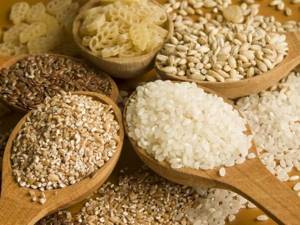
The patient's diet must be balanced in terms of its chemical composition. It is recommended to eat 300 g of slow carbohydrates (beans, cereals), 70-80 g of vegetable and animal protein (vegetables, meat, eggs), healthy fats up to 70 g per day. You should be especially careful with spices when preparing food. The amount of salt also needs to be reduced, the recommended amount per day is 6 g.
As for heat treatment, you should avoid frying in large amounts of oil. You can bake, boil, steam or cook in a slow cooker. It is advisable to consume food and drinks warm; too hot or cold is undesirable for the central nervous system.
In addition to nutrition, the patient should drink enough purified water. It is better not to use ordinary carbonated water; periodically it is useful to drink water enriched with useful minerals. The calorie intake per day should be no more than 2500 kcal.
Loss of appetite is a common occurrence when there is a malfunction in the nervous system; the patient may refuse to eat or, conversely, overeat. It is important to ensure that the diet is moderate and balanced.
How to eat properly at the “diet table”: the basic principles of gentle diets
The rules for organizing treatment tables appropriate for a specific disease are strictly applied when providing food in hospitals, dispensaries and sanatorium-resort institutions. The list of foods allowed on a particular gentle diet may vary significantly - for example, a diet for stomach ulcers strictly prohibits foods that stimulate the production of gastric juice (including raw vegetables and fruits), and on a diet for gastritis with low acidity, the doctor does the opposite , may recommend introducing white cabbage and citrus fruits into the diet.
The approach to the consumption of protein products also varies: for some diseases of the gastrointestinal tract, a menu with a relatively high content of meat, fish (seafood), eggs, milk is beneficial, and, for example, the “Table 3 according to Pevzner” diet, recommended for constipation, the amount of proteins supplied with meat food, is limited to 4-5 meals per week, but experts advise consuming more fermented milk.
However, any nutrition plan used during the active stage of the disease or during the long-awaited period of recovery also prescribes a number of general rules. Among them:
No processed foods or fast food: all food should be freshly prepared and minimally industrially processed, spicy seasonings, additives (in the vast majority of gentle diets, also without salt). The only exception in terms of freshness is bread: in those “tables” where it is allowed, it is recommended to eat yesterday’s bread, which does not cause yeast fermentation in the intestines.
Special preparation methods: a gentle diet presupposes delicate nutrition and ease of absorption of all substances that may be useful. To do this, they need to be given the appropriate form: the food is steamed or boiled for a long time, pureed, and crushed as much as possible. Any food that involves the inclusion of dense fragments (tendons, seeds, peel), thorough chewing, long digestion is prohibited, as well as foods that are fraught with the risk of mechanical damage to the gastrointestinal tract (hard, dry food, coarse fiber).
Refusal of products that stimulate the nervous system: including those containing alcohol, sugar, white flour, natural stimulants (with caution and not in all gentle diets - refusal of tea, coffee, citrus fruits). After all, “calmness, only calmness” is required not only by those who, on the recommendation of specialists, adhere to diet No. 12 according to Pevzner..
Strong, not frayed nerves are the key to physical health in general, for everyone.
Eating food at a comfortable temperature: served dishes should have a temperature of 40 to 60 degrees Celsius; On a gentle diet, you should avoid both scalding hot and excessively cold foods, which additionally strain the organs of the gastrointestinal tract. In addition, extreme serving temperatures impair the absorption of nutrients.
Fractional meals: Most dietary tables according to Pevzner in their recommendations are based on the principle of fractional meals: more frequent (5-7 times a day), but small portions - this allows the digestive system to cope with its task more easily.
Reviews and results
There are not many reviews from patients, but mostly positive.
“... After the annual report and trips to the tax office, my mental state worsened. I lash out at my subordinates, I can’t concentrate, so I constantly drink cups of very strong tea or coffee. I don’t sleep well, I can’t fall asleep, I fall asleep tired. The mood is constantly bad. Drinking alcohol does not relieve stress. I had to see a neurologist. They prescribed medications and advised to exclude all pathogens from the diet - tea, coffee, chocolate, alcohol. I started doing exercises, taking water treatments, and taking walks in the park in the evenings. After two months, the condition returned to normal, but I was already accustomed to the new way of life and decided to switch to it in the future.”
General recommendations for dietary tables according to Pevzner
In addition to the individual prohibitions that exist for each table, there are a number of general recommendations that M. Pevzner adhered to. They are based on his personal experience as a nutritionist and medical beliefs.
1. So, from the memoirs of Manuil Isaakovich’s colleagues we learn about his dislike for spices. “Pevzner strongly opposed the use of spices and seasonings in Soviet cuisine, as stimulating and harmful,” they write. The maximum seasonings allowed were limited to salt and black pepper.
2. Also, the Soviet nutritionist considered fried foods to be a real scrap: “... furiously cursed all fried foods and recommended that, as a last resort, they be cooked in butter or margarine.”
3. The third feature of all nutrition systems according to Pevzner is taking into account the composition of consumed dishes. Manuil Pevzner and his followers were the first in Soviet dietetics who advocated a formal approach to evaluating food and proposed calculating how much fat, protein, carbohydrates and mineral salts it contained.
4. Pevzner believed that mineral salts and vitamins play a vital role in the treatment and maintenance of patients with chronic diseases. The most organic way to consume them is from raw vegetables, fruits and berries, the nutritionist said. For gastrointestinal diseases, when none of these products could be included in the menu, Pevzner offered freshly squeezed skoye.
Read also: Amosov pasta: the best recipe for heart health and longevity
Table: what you can and cannot eat
| Products | Can be consumed | Cannot be consumed |
| Vegetables and greens |
|
|
| Fruits |
| – |
| Berries |
| – |
| Nuts and dried fruits |
| – |
| Cereals and porridges |
|
|
| Flour and pasta |
|
|
| Bakery products |
| – |
| Confectionery |
|
|
| Raw materials and seasonings |
|
|
| Dairy |
| – |
| Meat products and poultry |
|
|
| Fish and seafood |
|
|
| Oils and fats |
|
|
| Non-alcoholic drinks |
|
|
| Other drinks |
|
|
